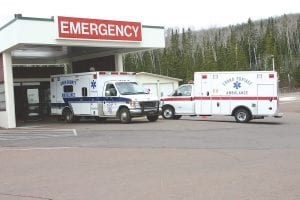An emergency medical technician (EMT) course is beginning soon and the Cook County Ambulance service encourages anyone interested in becoming an EMT—and member of the ambulance squad—to take the training. Speaking with the Cook County News- Herald recently, Ambulance Director Steve DuChien said the need for more EMTs is great.
With just six paid staffers and 11 volunteers, Cook County Ambulance is stretched pretty thin. Especially considering the ambulance service covers the City of Grand Marais, and the townships of Lutsen, Tofte and part of Schroeder, as well as making ambulance runs to Duluth hospitals when needed—sometimes two or three times a day.
The ambulance service has 60 shifts to fill per month with two people per shift and two shifts each day. Ambulance workers are on-call or in service for 12 hours with one shift from 6 a.m. to 6 p.m. and the other from 6 p.m. to 6 a.m.
The five paid staffers are DuChien; two paramedics, Jeff Dennison and Sheila Costello who also work with patients when not on the ambulance; Mike Flack who also works as the hospital’s purchasing agent along with Rebecca Frost and Nicole Bockovich who both work in the hospital labor pool.
DuChien said in addition to needing more EMTs, the hospital is looking for a paramedic to work “casual,” to fill in if the two paramedics are not available. That is tough, said DuChien. “Rural Minnesota is really challenged. It is hard to find someone who can work as a ‘casual’ paramedic. We are hoping that there might be a retired paramedic in the county who might be interested,” he said.
It’s also hard to find people who can serve on the ambulance. EMTs receive pagers and radios and can carry on with their other work or family duties while on call. However, they have to be at the ambulance garage within five minutes of an emergency call. “And they must obey all traffic laws,” DuChien added, “No speeding or running stop signs!”
DuChien said most of the current EMTs have other jobs—sometimes multiple jobs—and the ambulance service tries to work around those schedules. However, that limits the pool of people to take ambulance calls.
EMTs on the ambulance squad are considered volunteers, however they do receive a stipend for their service. While on call, EMTs receive an hourly rate. If EMTs are paged to a local call, they receive a flat rate. They also received a flat rate for patient transfers to Duluth, which typically take 5-6 hours. Ambulance workers also have a life insurance benefit.
The reward for serving on the ambulance is much more than monetary, however, said DuChien. He acknowledges that there are times that being on the ambulance is very stressful. The vast majority of calls are to assist friends and neighbors—and sometimes family. He said every EMT has the memory of a call or two that haunts him or her. There are professionals available in those instances, said DuChien, which helps.
But far outweighing that is the knowledge that you are helping the community, said DuChien. Asked if he could share the best call ever responded to, DuChien smiled. Fortunately, there are too many recount. However, he said the first time the heart defibrillator was ever used the field was one of the most rewarding. “They would not have survived without it. And they survived!” said DuChien happily.
“It’s giving something back to the community, to our quality of life. What would the community be without pre-hospital care? It would be like back in the 1920s when people died from injuries they shouldn’t have died from,” he said.
EMT training will be offered in Cook County by Hibbing Community College this month. The course is 160 hours of instruction; some in the classroom and some hands-on skills development.
North Shore Hospital pays for EMT training (an expense of approximately $1,450) if students complete
the training and serve for a year on the ambulance, taking a minimum of eight shifts per month. “It’s an investment for
our hospital,” said DuChien.
There are continuing education requirements to ensure that EMTs are up-to-date with modern medical protocols.
In fact, DuChien said with a grin, he won’t be helping teach the next EMT class as he usually does, as it is time for
him to take a refresher.
There is no limit to the number of ambulance crew members that North Shore Hospital can have, in fact the more the better, said DuChien. Ideally he would like to see a large enough pool of EMTS that members could only take eight shifts per month if they wished.
DuChien said the ambulance service can arrange for people willing to abide by health care privacy guidelines to ride along in the ambulance to get an idea of what the job entails. People wondering if they would like working as an EMT are encouraged to contact DuChien. Stop by North Shore Hospital and ask for him or give him a call at 218-387-3262 or email him at steve. duchien@northshorehealthgm.org.
Emergency Medical Technician (EMT) training
Wednesday, February 10
Cook County/North Shore
Hospital large classroom
For more details, contact Steve DuChien at 218-387-3784



Loading Comments